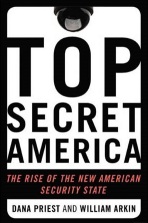Book review: 'Top Secret America'
By Bob Drogin, Los Angeles Times
October 17, 2011
 The CIA was nominally in charge when Navy SEALs flew deep into Pakistan in radar-evading Stealth helicopters in May to kill Osama bin Laden and when Predator drones fired missiles to kill Anwar Awlaki in Yemen last month.
The CIA was nominally in charge when Navy SEALs flew deep into Pakistan in radar-evading Stealth helicopters in May to kill Osama bin Laden and when Predator drones fired missiles to kill Anwar Awlaki in Yemen last month.
But America's fabled spy service was eclipsed in both raids by a far more secretive group that flies 10 times as many drones as the CIA. Based in North Carolina, it runs its own intelligence division, flies its own reconnaissance planes and has its own satellites. Its leaders don't speak in public. It has no media spokesman or public website.
In "Top Secret America," Dana Priest and William M. Arkin, two of America's most relentless reporters, pull the curtains back on JSOC, or Joint Special Operations Command, to reveal a self-sustaining secret Pentagon army that has captured or killed more Al Qaeda militants "than the rest of the U.S. government forces combined."
This is an invaluable book, a breathtaking investigative account of America's vast new secret world. It is not light reading, but it offers an indispensable guide to anyone who worries about the explosive growth of what the authors call America's terrorism-industrial complex since the Sept. 11 attacks a decade ago.
In their book, based on several hundred interviews, Priest and Arkin map out a largely invisible parallel universe of more than 1,300 federal agencies, nearly 2,000 private companies and 854,000 people doing "top secret" work. Spending for counter-terrorism, they note, has skyrocketed without members of Congress or anyone else really knowing what works and what does not.
A few examples: Some $81 billion is spent to gather foreign intelligence. The Homeland Security Department spends $58 billion, while the Pentagon spends untold billions more on counter-terrorism and homeland security. With so many duplicative agencies, bureaus, programs and gizmos, the counterterrorism effort is beset with "disturbing dysfunction."
Priest, who has won two Pulitzer Prizes for her reporting, is an intrepid tour guide to this uncharted world. Visiting suspect sites around the country, she shares her frustrations at chasing what she calls "buildings without addresses, offices without floors, acronyms without explanation."
Arkin is the kind of sleuth who mines impenetrable government documents to write directories of nuclear weapons, classified code names and much more. So when Priest searches for a mysterious underground bunker in rural Maryland, Arkin digs into his stash of "contracts for guard and facility maintenance services" and reports that the buried facility is 90,000 square feet and has a helicopter pad on top.
And it's hardly the biggest government bunker. In all, Arkin determines that 33 large complexes for top secret intelligence work have been built around Washington in recent years — equivalent in size to three Pentagons. That doesn't include five new buildings to house the ever-expanding CIA, a vast new complex for the National Security Agency in Utah and scores of other facilities around the country. Much of the top secret work is doled out to savvy corporate contractors, which have boomed in the recession. Some offer shiny BMWs and fat bonuses to hire away CIA analysts and others with top secret security clearances so they can then offer them back to government agencies at inflated prices.
The burden is substantial. The authors cite a recent study by the Office of the Director of National Intelligence (another group created in the last decade) which found that private contractors make up 29% of the workforce in intelligence agencies but cost 49% of personnel budgets.
Does the bloated system work? The two plots that have come closest to causing mass murder in the United States — the attempt to blow up a Northwest Airlines jet over Detroit in December 2009 and the attempt to detonate a car bomb in New York's Times Square in May 2010 — both failed because the bombers were incompetent, not because of U.S. efforts. Both were intelligence failures.
Robert Gates, the former CIA chief and Defense secretary, tells the authors that he is appalled at the constant fear-mongering about dirty bombs, killer germs, a cyber Pearl Harbor and other threats. U.S. courts have tried 46 terrorism cases involving 125 people in recent years, he points out. "So, I would say the numbers of extremists are very small. Let's stay calm."
There are no heroes or villains here — it's more a story of a system run amok. In Washington, it is said, the easiest way to get more money is to fail. After the tragedy of Sept. 11, Congress gave a virtual blank check to America's secret security agencies and provided no public accountability to stop fraud or malfeasance. Priest and Arkin explain better than Congress ever has the staggering waste and ineptitude that inevitably has followed.
bob.drogin@latimes.com